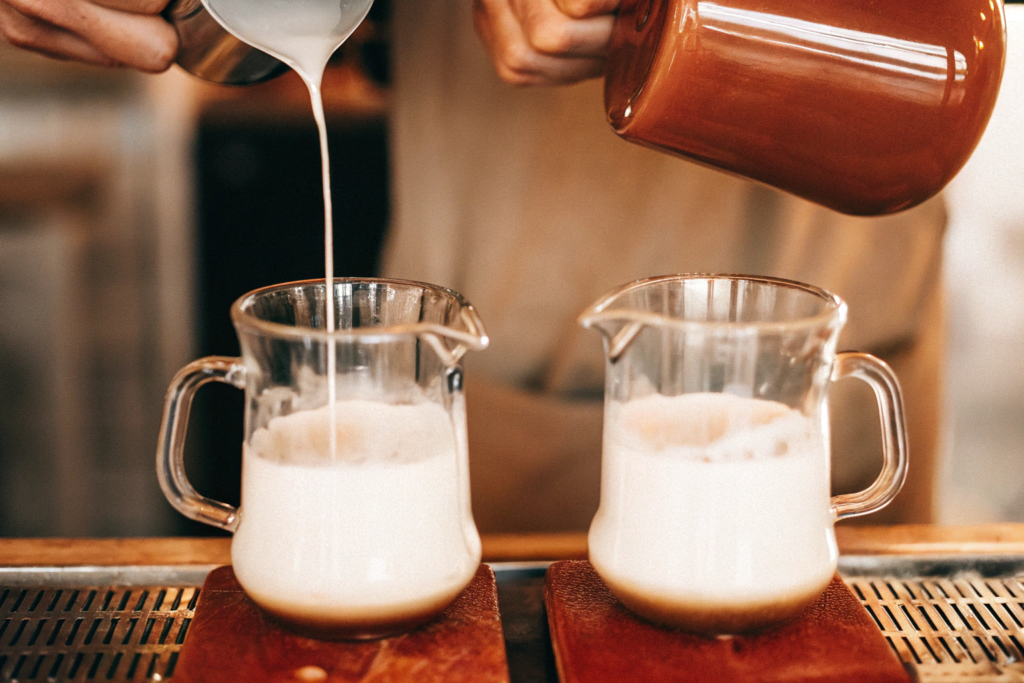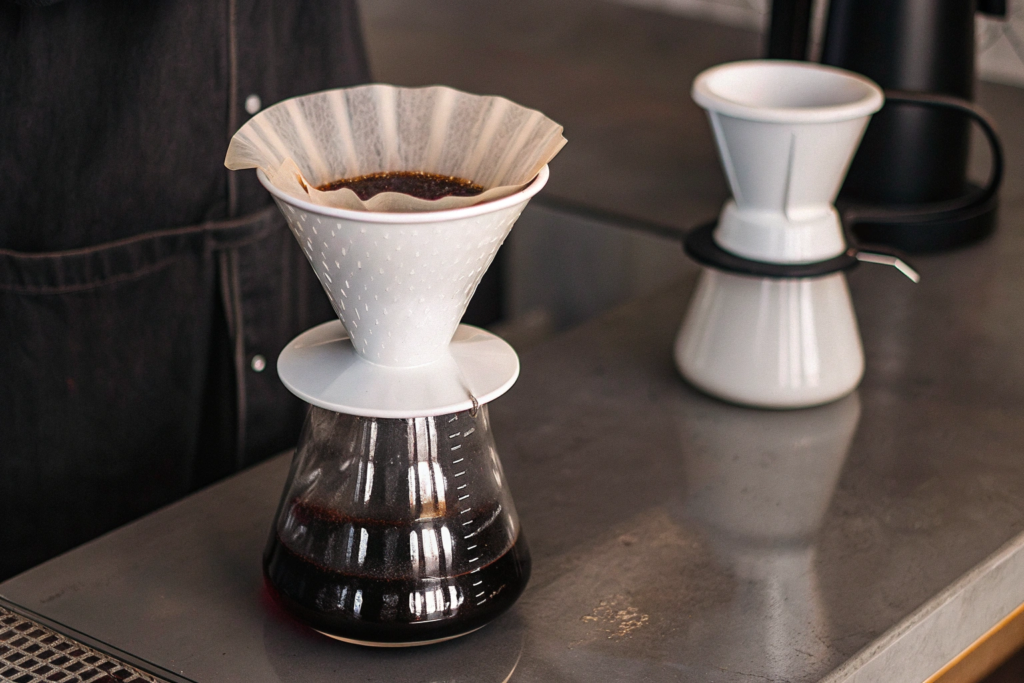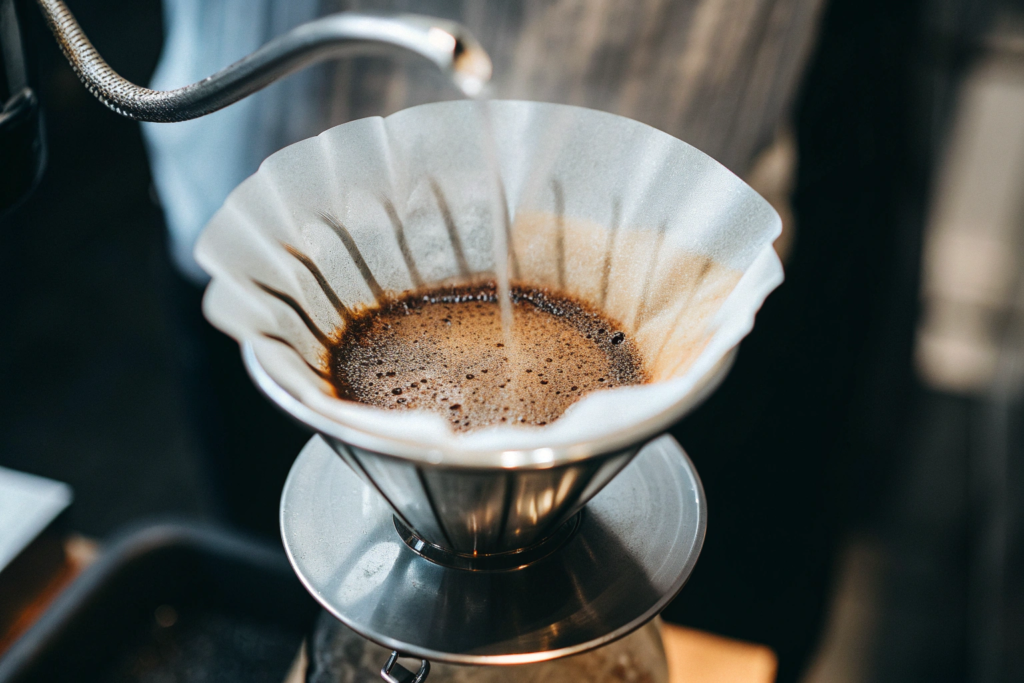I used to struggle making coffee for two people. It was frustrating watching one cup get cold while I made the second one. This problem had me searching for better ways to serve coffee efficiently.
To pour two cups of coffee simultaneously, you can use the alternating pour technique, split pitchers, brew with multiple devices, or scale up your recipe and use a carafe. These methods can save time and ensure everyone enjoys fresh, hot coffee together.

I want to share some methods I've discovered after years of making coffee for friends and customers. These techniques have saved me lots of time and made sure everyone gets to enjoy their coffee while it's still hot.
What is the alternating pour method and how does it work?
When making multiple coffees, I hated seeing one drink cool down while I prepared the next. The alternating pour method fixed this problem by keeping both drinks at the right temperature.
The alternating pour method means pouring milk or coffee back and forth between two cups. You start with one cup, switch to the second before the first is full, and keep going back and forth until both cups have the right amount.

The alternating pour method takes practice but soon becomes easy. I put both cups close together on a flat surface where I can move between them quickly. The secret is in the timing and control. I use a gooseneck kettle for coffee since it gives me better control, while a good milk pitcher works best for milk drinks.
When I first tried this method, I made the mistake of pouring too much in the first cup before switching. This created uneven cups. Through practice, I found that switching after pouring about 20-30% into each cup works best. This helps keep the temperature and extraction consistent for both cups.
This technique is especially helpful for baristas during busy times. I pour espresso shots in an alternating pattern, then follow with steamed milk the same way. This makes sure both drinks have similar crema and temperature. The rhythm becomes almost meditative once you master it—pour, switch, pour, switch—letting you serve two customers in almost the same time as one.
How can splitting pitchers help with simultaneous coffee service?
I once faced the challenge of making multiple latte art drinks at once without losing quality. Splitting pitchers became my solution for keeping milk texture and temperature consistent.
Splitting pitchers involves dividing steamed milk between separate pitchers before pouring. You steam a larger amount of milk in one pitcher, then split it into two smaller pitchers for pouring at the same time, which keeps the temperature and texture the same for both drinks.

I've refined the splitting pitchers technique over hundreds of coffee sessions, and it's changed how I handle multiple orders. I start by properly steaming a larger volume of milk—usually 12-16 oz instead of the normal 6-8 oz for one drink. The most important part is getting perfect microfoam texture that will stay good when divided.
After steaming, I quickly but carefully divide the milk between two smaller pitchers. I like using 4-6 oz pitchers for this because they give better control for latte art. The division needs to happen fast to prevent the milk from cooling, which I've found is the biggest challenge with this method. I use a small funnel to avoid spills during the transfer, though experienced baristas can pour directly with little mess.
What makes this technique work so well is that both portions of milk have the same texture and temperature, ensuring consistent drinks. In my café work, I often prepare the espresso shots first (though not letting them sit for more than 10-15 seconds), then use the splitting pitcher technique to finish both drinks almost at the same time. This has greatly reduced my service time while keeping the quality my customers expect. For home baristas with guests, this method eliminates having to decide who gets served first.
Can pour-over methods be adapted for brewing two cups at once?
I was tired of the time it took to make individual pour-overs for guests. After testing different approaches, I found several ways to modify standard pour-over methods for serving two people efficiently.
Pour-over methods can be adapted for two cups by scaling your recipe, using wider brewers like the Chemex, using the Aeropress as a pour-over device with a metal filter, or using a Clever Dripper with increased coffee and water amounts.

Adapting pour-over methods for dual brewing has become my specialty after years of serving coffee to friends. The simplest approach is properly scaling a recipe, which is more than just doubling everything. When I increase from one to two cups, I adjust my coffee-to-water ratio slightly (typically using a 1:16 ratio instead of 1:17 for single cups) and make the grind a bit coarser to account for the longer brew time.
The equipment you choose makes a big difference. I've found the Chemex works well due to its larger size and wider brewing bed, which allows for more even extraction with larger volumes. For my Hario V60, I use the 03 size with a slightly coarser grind to prevent clogging as more water passes through more coffee.
Using the Aeropress as a pour-over device was a game-changer for me. By removing the plunger, inserting a metal filter (paper filters tend to clog), and placing it over a server big enough for two cups, I created an effective small-batch brewer. The key adjustment was using a much coarser grind (similar to French press) and extending the brew time by about 30%. This method made remarkably clean cups with excellent flavor.
The Clever Dripper offers another good option. I either double my standard recipe for immersion brewing or use it as a pour-over by keeping the valve open and brewing directly into a server. For immersion, I extend the steep time by about 1-2 minutes when doubling the volume to ensure proper extraction. The controlled release valve makes this method especially forgiving for those new to brewing multiple cups.
Brewing Parameters for Two-Cup Pour-Overs
| Method | Coffee Amount | Water Amount | Grind Size | Brew Time |
|---|---|---|---|---|
| V60 (02) | 30-34g | 480-510ml | Medium | 3:00-3:30 |
| Chemex | 34-38g | 510-540ml | Medium-Coarse | 4:00-4:30 |
| Aeropress (Pour-Over) | 28-30g | 450-480ml | Coarse | 2:30-3:00 |
| Clever Dripper | 32-36g | 480-520ml | Medium | 3:30-4:00 (steep) |
How important is temperature control when brewing multiple cups?
I've had times when two seemingly identical coffees tasted noticeably different. The cause was inconsistent water temperature, a factor that becomes even more important when brewing multiple cups.
Precise temperature control is essential when brewing multiple cups of coffee. Keep water between 195-205°F throughout brewing using a good variable temperature kettle or by pre-heating your brewing equipment to ensure consistent extraction across all cups.

Through my experience as both a home and professional barista, I've learned that temperature stability is perhaps the most overlooked element of consistent multi-cup brewing. When I first started brewing for groups, I noticed the second cup often tasted different from the first—usually more bitter. After testing various factors, I discovered that temperature fluctuation was the main cause.
My solution started with buying a good variable temperature kettle that maintains the set temperature rather than just reaching it and turning off. This ensures that when I'm brewing two pour-overs in sequence or using methods like the alternating pour, the water temperature stays consistent throughout. I typically set my kettle to 205°F for light to medium roasts and 200°F for darker roasts.
Beyond equipment, I developed a pre-heating routine that greatly improved consistency. I now pre-heat all brewing equipment, servers, and cups with hot water before starting the brewing process. This prevents the brewing water from losing heat when it touches room-temperature equipment. For methods like the Clever Dripper, where the coffee and water stay in contact longer, I found that wrapping the brewer with a small towel helps maintain temperature during the extended brewing time.
When serving multiple guests, I also discovered that using a pre-heated thermal carafe as an intermediate vessel before pouring into cups kept the temperature stable and allowed everyone to enjoy equally hot coffee. This approach also improved flavor consistency, as the brief resting time in the carafe allowed the coffee to fully develop its flavor before serving.
Temperature Effects on Extraction
| Temperature Range | Effect on Flavor | Best For |
|---|---|---|
| 195-198°F (90-92°C) | Less acidity, more sweetness | Dark roasts, chocolatey coffees |
| 199-202°F (93-94°C) | Balanced extraction | Medium roasts, most coffees |
| 203-205°F (95-96°C) | Higher acidity, more complexity | Light roasts, fruity coffees |
What role does the grind size play when brewing for two?
I once doubled my coffee recipe without adjusting the grind size and ended up with a bitter, over-extracted brew. Understanding grind size adjustments is crucial when scaling your brewing method for two cups.
When brewing coffee for two people, slightly coarsen your grind from your single-cup setting. This adjustment compensates for the longer extraction time needed for larger volumes and helps maintain balanced flavor without over-extraction or bitterness.

Grind size adjustment has become my secret weapon for consistent multi-cup brewing. Through many brew sessions and taste tests, I've found that simply doubling a recipe without changing the grind size almost always leads to disappointing results. The science relates to extraction dynamics—larger coffee beds create different flow patterns and extraction rates than smaller ones.
When I scale up from a single cup to a two-cup batch, I typically adjust my grinder one or two settings coarser. This small change compensates for the longer contact time between water and coffee in larger brews. For my electric burr grinder[^1], this means moving from a setting of 15 to 16 or 17 for pour-overs, or from 20 to 22-23 for immersion methods like the French Press. These numbers are specific to my equipment, but the principle applies to all grinders.
The relationship between grind size and brew time becomes even more important with methods like the Aeropress when used as a pour-over device for two cups. In this case, I've found that a much coarser grind—almost at French Press level—works best to prevent clogging while allowing proper extraction of the larger coffee bed. With the Clever Dripper, a slightly coarser grind combined with a longer immersion time (about 30-45 seconds more) produces the most balanced results.
I keep a brewing journal[^2] where I record the grind settings that work best for different batch sizes across various brewing methods. This practice has shown interesting patterns—for example, darker roasts generally need less grind size adjustment[^3] when scaling up compared to lighter roasts, which tend to be more sensitive to extraction variables. For consistency, I recommend using a quality burr grinder with numbered settings rather than blade grinders, which can't provide the precision needed for these adjustments.
Grind Size Adjustments by Brewing Method
| Brewing Method | Single Cup Grind | Two Cup Adjustment | Resulting Extraction Time |
|---|---|---|---|
| V60 | Medium-Fine (15)* | +1-2 settings coarser (16-17) | +30-45 seconds |
| Chemex | Medium (18)* | +2 settings coarser (20) | +45-60 seconds |
| Aeropress (Pour-Over) | Medium (17)* | +5 settings coarser (22) | +30 seconds |
| French Press | Coarse (22)* | +1-2 settings coarser (23-24) | +1 minute |
*Numbers reference typical grinder settings and will vary by equipment
Conclusion
Pouring two cups of coffee at the same time is possible through several methods including alternating pours, splitting pitchers, adapting pour-over techniques, and paying attention to temperature and grind size. These approaches have changed how I serve coffee, letting me serve multiple people efficiently without sacrificing quality.
---
[^1]: Exploring the advantages of electric burr grinders can help you choose the right equipment for optimal coffee extraction.
[^2]: A brewing journal can help you track your experiments and refine your technique for consistently great coffee.
[^3]: Understanding grind size adjustment can enhance your brewing technique, leading to better flavor and consistency in your coffee.



